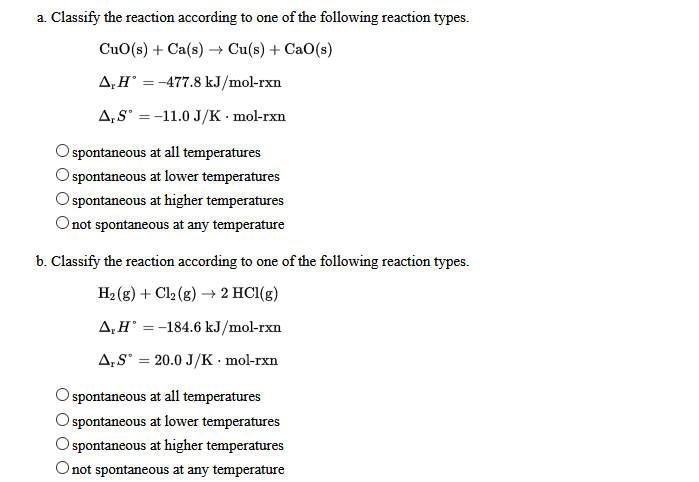- Classify the reaction according to one of the following reaction types. CuO(s) + Ca(s) → Cu(s) + CaO(s) A,H° =-477.8 kJ/mol-rxn A,s' =-11.0 J/K · mol-rxn O spontaneous at all temperatures spontaneous at lower temperatures spontaneous at higher temperatures Onot spontaneous at any temperature . Classify the reaction according to one of the following reaction types. H2 (g) + Cl2 (g) → 2 HCl(g) A‚H° =-184.6 kJ/mol-rxn A;s' = 20.0 J/K · mol-rxn spontaneous at all temperatures O spontaneous at lower temperatures Ospontaneous at higher temperatures Onot spontaneous at any temperature
- Classify the reaction according to one of the following reaction types. CuO(s) + Ca(s) → Cu(s) + CaO(s) A,H° =-477.8 kJ/mol-rxn A,s' =-11.0 J/K · mol-rxn O spontaneous at all temperatures spontaneous at lower temperatures spontaneous at higher temperatures Onot spontaneous at any temperature . Classify the reaction according to one of the following reaction types. H2 (g) + Cl2 (g) → 2 HCl(g) A‚H° =-184.6 kJ/mol-rxn A;s' = 20.0 J/K · mol-rxn spontaneous at all temperatures O spontaneous at lower temperatures Ospontaneous at higher temperatures Onot spontaneous at any temperature
Chemistry for Engineering Students
4th Edition
ISBN:9781337398909
Author:Lawrence S. Brown, Tom Holme
Publisher:Lawrence S. Brown, Tom Holme
Chapter10: Entropy And The Second Law Of Thermodynamics
Section: Chapter Questions
Problem 10.50PAE: For the reaction NO(g)+NO2(g)N2O3(g) , use tabulated thermodynamic data to calculate H and S. Then...
Related questions
Question
100%

Transcribed Image Text:a. Classify the reaction according to one of the following reaction types.
CuO(s) + Ca(s) Cu(s) + CaO(s)
A,H° = -477.8 kJ/mol-rxn
A,S° = -11.0 J/K· mol-rxn
O spontaneous at all temperatures
O spontaneous at lower temperatures
O spontaneous at higher temperatures
O not spontaneous at any temperature
b. Classify the reaction according to one of the following reaction types.
H2 (g) + Cl2 (g) → 2 HCl(g)
A,H° =-184.6 kJ/mol-rxn
A.S° = 20.0 J/K · mol-rxn
O spontaneous at all temperatures
O spontaneous at lower temperatures
spontaneous at higher temperatures
Onot spontaneous at any temperature
Expert Solution
This question has been solved!
Explore an expertly crafted, step-by-step solution for a thorough understanding of key concepts.
This is a popular solution!
Trending now
This is a popular solution!
Step by step
Solved in 5 steps with 2 images

Knowledge Booster
Learn more about
Need a deep-dive on the concept behind this application? Look no further. Learn more about this topic, chemistry and related others by exploring similar questions and additional content below.Recommended textbooks for you

Chemistry for Engineering Students
Chemistry
ISBN:
9781337398909
Author:
Lawrence S. Brown, Tom Holme
Publisher:
Cengage Learning

Chemistry
Chemistry
ISBN:
9781305957404
Author:
Steven S. Zumdahl, Susan A. Zumdahl, Donald J. DeCoste
Publisher:
Cengage Learning

Chemistry: An Atoms First Approach
Chemistry
ISBN:
9781305079243
Author:
Steven S. Zumdahl, Susan A. Zumdahl
Publisher:
Cengage Learning

Chemistry for Engineering Students
Chemistry
ISBN:
9781337398909
Author:
Lawrence S. Brown, Tom Holme
Publisher:
Cengage Learning

Chemistry
Chemistry
ISBN:
9781305957404
Author:
Steven S. Zumdahl, Susan A. Zumdahl, Donald J. DeCoste
Publisher:
Cengage Learning

Chemistry: An Atoms First Approach
Chemistry
ISBN:
9781305079243
Author:
Steven S. Zumdahl, Susan A. Zumdahl
Publisher:
Cengage Learning


Chemistry by OpenStax (2015-05-04)
Chemistry
ISBN:
9781938168390
Author:
Klaus Theopold, Richard H Langley, Paul Flowers, William R. Robinson, Mark Blaser
Publisher:
OpenStax

Chemistry & Chemical Reactivity
Chemistry
ISBN:
9781337399074
Author:
John C. Kotz, Paul M. Treichel, John Townsend, David Treichel
Publisher:
Cengage Learning